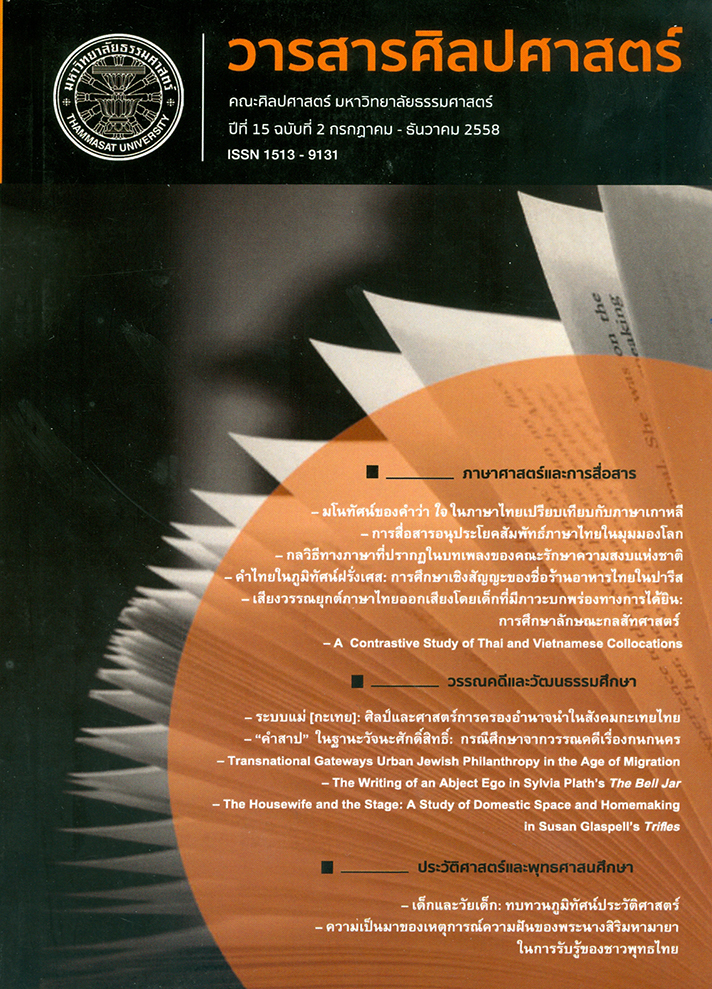A Contrastive Study of Thai and Vietnamese Collocations
Main Article Content
บทคัดย่อ
This study implemented a contrastive analysis to find the similarities and the differences between collocations in Thai and Vietnamese that convey the five sensory perceptions of: sight, taste, smell, hearing, and touch. In total 548 collocations were studied. Data analysis was divided into 3 parts: (1) the components of collocations used in Thai and those used in Vietnamese; (2) the 8 categories of the collocation combination structures: a noun with a noun, a noun with an adjective, a noun with a verb, a verb with a verb, a verb with an adverb, a verb with a noun, an adjective with an adjective, and an adjective with a noun; and (3) the comparison between collocations used in Thai and those used in Vietnamese, which were categorized into three types. The results showed that 1) there were 404 similar collocations or 73.72%, and 144 different collocations or 26.28%, 2) concerning the collocation combination structures, there were 422 similar collocation structures or 77.01% while there were 126 different collocation structures or 22.99%, and 3) there were more similarities than differences. The study revealed that there were 372 collocations of similar classifications or 67.88%and 176 collocations of different classifications or 32.12%. The collocations are arbitrary, thus, this study of the similarities and the differences of collocations in the languages can be a guideline for improving and increasing efficiency in both learning and teaching Vietnamese in terms of implementing correct, appropriate, and natural choices of collocations in classroom interaction.
Keywords: Base word, Collocator, Collocations, Thai, Vietnamese
การศึกษาครั้งนี้ มีวัตถุประสงค์เพื่อวิเคราะห์เปรียบเทียบหาความเหมือนและความแตกต่างของคำปรากฏร่วมวลีในภาษาไทยและภาษาเวียดนามที่เกี่ยวกับประสาทสัมผัสทั้ง 5 คือ รูป รส กลิ่น เสียง สัมผัส โดยการนับจำนวนและคิดเป็นร้อยละ ข้อมูลมีจำนวนทั้งสิ้น 548 คำปรากฏร่วมวลี โดยแบ่งการวิเคราะห์ออกเป็น 3 ส่วน คือ ส่วนที่ 1 ศึกษา ส่วนประกอบคำปรากฏร่วมวลีในภาษาไทยและภาษาเวียดนาม ส่วนที่ 2 ศึกษาโครงสร้างคำปรากฏร่วมวลีในภาษาไทยและภาษาเวียดนาม ซึ่งมีทั้งหมด 8 กลุ่ม คือ คำนามกับคำนาม คำนามกับคำคุณศัพท์ คำนามกับคำกริยา คำกริยากับคำกริยา คำกริยากับคำกริยาวิเศษณ์ คำกริยากับคำนาม คำคุณศัพท์กับคำคุณศัพท์ และคำคุณศัพท์กับคำนาม ส่วนที่ 3 ศึกษาเปรียบเทียบประเภทของคำปรากฏร่วมวลีในภาษาไทยกับภาษาเวียดนามมีทั้งหมด 3 ประเภท การศึกษาส่วนที่หนึ่งพบว่า มีความเหมือนมากกว่าความแตกต่าง คือมีส่วนประกอบคำปรากฏร่วมวลีที่ความเหมือนกัน 404 คำปรากฏร่วมวลี คิดเป็นร้อยละ 73.72 และมีความแตกต่างกัน 144 คำปรากฏร่วมวลี คิดเป็นร้อยละ 26.28 ส่วนที่สองพบว่า โครงสร้างคำปรากฏร่วมวลีมีความเหมือนมากกว่าความแตกต่าง คือ มีความเหมือนกัน 422 โครงสร้างคำปรากฏร่วมวลีคิดเป็นร้อยละ 77.01 และมีโครงสร้างคำปรากฏร่วมวลีที่มีความแตกต่างกันคิดเป็นร้อยละ 22.99 ส่วนที่สามพบว่า ประเภทของคำปรากฏร่วมวลีมีความเหมือนมากกว่าความแตกต่าง คือมีความเหมือนกัน 372 ประเภท คิดเป็นร้อยละ 67.88 และมีความแตกต่างกัน 176 ประเภท คิดเป็นร้อยละ 32.12 คำปรากฏร่วมวลีไม่มีกฎเกณฑ์ตายตัว ดังนั้น การศึกษาความเหมือนและความแตกต่างของภาษาจะเป็นแนวทางในการปรับปรุงและช่วยเพิ่มประสิทธิภาพในการเรียนการสอนภาษาเวียดนามและเป็นแนวทาง ในการเลือกใช้คำที่เกิดร่วมกันอย่างถูกต้อง เหมาะสม และเป็นธรรมชาติ
คำสำคัญ คำศัพท์ฐาน คำศัพท์ร่วม คำปรากฏร่วมวลี ภาษาไทย ภาษาเวียดนาม


